It is time to answer the question, what is gluconeogenesis? But first, it is important to know some background information on your body’s fat-burning process:
Eat fat burn fat. Eat carbs burn carbs. It’s that simple, right? Yes and no. There’s more to it.
Your body has many different metabolic pathways that it uses to provide energy for your cells. Glycolysis (using sugar for fuel) and lipolysis (using fat for fuel through beta-oxidation) are the most well-known metabolic pathways, but there are many more. One pathway, in particular, can turn the amino acids from protein into fuel.
Why does it matter? Because this may be the one thing that is holding you back from getting into ketosis and losing fat while you are on a ketogenic diet.
Gluconeogenesis — Your Liver’s “Magic Trick”
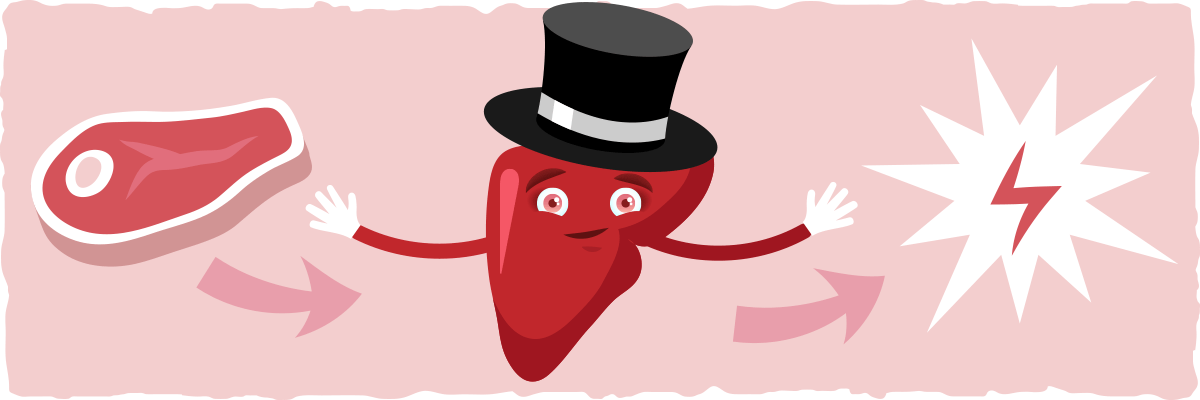
If you are under some form stress or consume excess protein, your liver will perform a magic trick called gluconeogenesis. This literally translates to “the making of (genesis) new (neo) sugar (gluco)”.
During gluconeogenesis, the liver (and occasionally the kidneys) turns non-sugar compounds like amino acids (the building blocks of protein), lactate, and glycerol into sugar that the body uses a fuel. When glycogen (your body’s sugar storage) is low, protein intake is high, or the body is under stress, amino acids from your meals and your muscle become one of your main energy sources.
If your body continues to convert amino acids into fuel, it can keep you from getting into ketosis. This is why some ketogenic dieters may experience an increase in body fat percentage and a decrease in muscle mass during their first couple weeks on the ketogenic diet.
But there is no need to worry. The ketogenic diet will still help reverse common health issues like diabetes and obesity and improve health in many ways. When you start the diet, however, gluconeogenesis will get in the way.
Is Gluconeogenesis Bad? One of the Problems With Going Ketogenic
During the first three days of the ketogenic diet, stored glycogen and amino acids are the body’s main fuel sources. At first, however, glycogen is the dominant fuel source. Once glycogen is almost all used up, amino acids from your food and your muscle become your main fuel source.
But the body can’t keep burning amino acids for fuel forever. We need them to perform many other functions that are necessary for our survival.
For example, amino acids help build and repair tissues like the hair, nails, bones, muscles, cartilage, skin, and blood. Many enzymes and hormones are made from amino acids as well. In other words, using amino acids as energy for a long period of time is a bad idea.
This is why the body has two other fuel sources — fat and ketones — that help preserve health and maintain muscle mass. The only problem is that the body doesn’t use them right away.
When Does The Body Use Ketogenesis Instead of Gluconeogenesis?
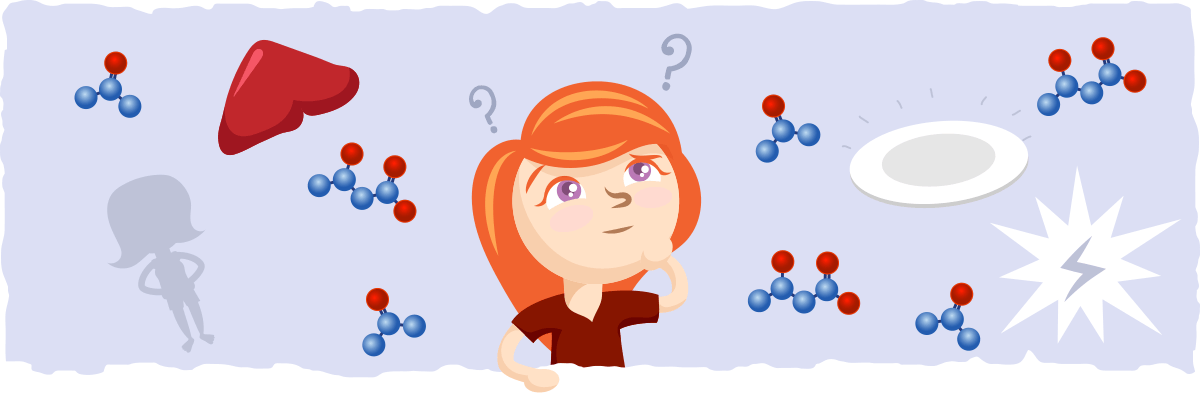
To find out when the body shifts into ketogenesis (using ketones as fuel), let’s look at what happens when the body is in a fasted state. In a review of multiple fasting studies, researchers found that it takes between 18 and 24 hours to deplete glycogen stores and more than 2 days after that for the body to shift into ketosis.
That’s two days without glycogen or ketones for fuel! How is the body fueling itself during that time? With gluconeogenesis.
In one case study, a 41-year-old healthy man decided to do a 40-day fast under medical supervision. To indirectly measure if he used amino acids for energy, researchers tracked the nitrogen levels in his urine.
During the first week of his fast, the man’s total urinary excretion of nitrogen was 10 to 12 grams per day. On the third week, it dropped significantly. According to the researchers, this significant drop in urinary nitrogen levels signifies that the man shifted from using mostly amino acids for fuel to using fat and ketones for fuel. A shift that took the man much longer than two days to accomplish.
It is important to realize, however, that this is what happened for one 41-year-old healthy man. Everyone responds to fasting and ketogenic diets differently.
Everyone has a Unique Path Through Gluconeogenesis to Ketogenesis
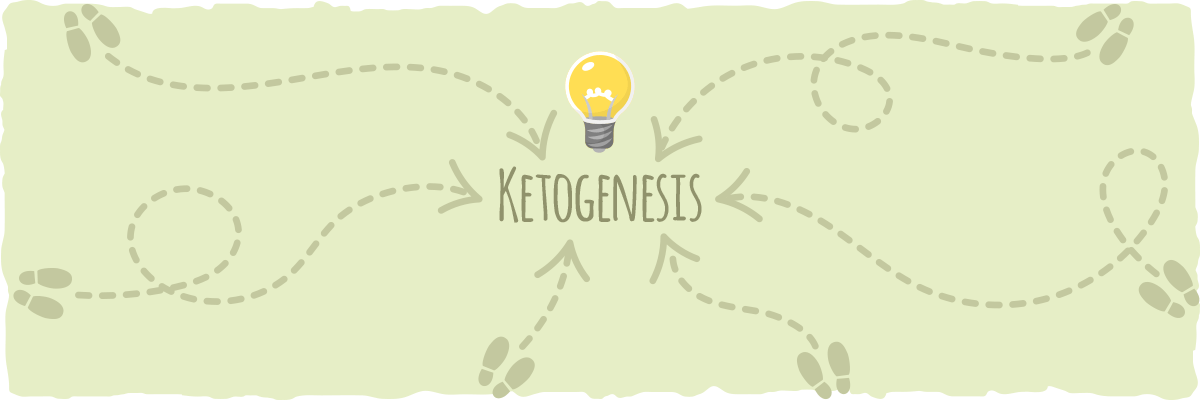
For example, another study had healthy volunteers of ideal weight (12 men and 12 women) fast for 6 days, and obese but otherwise healthy subjects (20 men, 28 women) fast for 6 to 28 days. In each group, there was a significant increase in urinary nitrogen loss from day 1 to day 3 of fasting, which was followed by a steady decrease.
These findings suggest that the rate at which we use gluconeogenesis decreases after the third day of fasting. Variations occur, however, when we look at the time it takes for different people to shift from gluconeogenesis to ketogenesis as the dominant metabolic pathway. To learn more about metabolic pathways and how they affect us, click here >
The men in this study, for example, tended to use gluconeogenesis for energy more than women. In other words, women got into deeper ketosis much more quickly than men.
The same trend was not found in obese subjects. Regardless if they were a man or a woman, obese subjects struggled to burn fat and ketones for fuel. So, what are we supposed to do with all of this information?
From Glycogenolysis to Gluconeogenesis to Ketogenesis — The Takeaway
Felig, a researcher who has a handful of published studies on fasting, summarizes the path to ketogenesis in three stages:
Stage 1 — The postabsorptive phase — 6 to 24 hours of fasting
During this phase, most energy is provided by glycogen.
Stage 2 — The gluconeogenic phase — 2 to 10 days of fasting
During this phase, glycogen is depleted and gluconeogenesis takes over to provide the body with energy. The window of time for this phase is so broad (two to ten days) because it depends on who is fasting. If you are a healthy male or obese, it will take longer for you to get to stage 3.
Stage 3 — The protein conservation phase — after 10 days of fasting
This phase is characterized by a decrease in protein breakdown for energy and an increase in fat and ketone use. Although Felig defines this phase as occurring after 10 days of fasting, many people enter this stage after three days of fasting.
There you have it — the three stages that everyone goes through before reaching ketosis. Whether you are fasting from carbohydrates (the ketogenic diet) or fasting from all food, you will go through these stages as well.
There is, however, an important caveat. It takes longer for your body to use ketogenesis rather than gluconeogenesis as the primary metabolic pathway while you are on the ketogenic diet. This is because of the effect that consuming protein has on insulin levels.
Gluconeogenesis from Excess Protein — The Reason Why You Are Not In Ketosis Yet
Although the ketogenic diet does not contain many insulin-raising carbohydrates, insulin levels will still be higher on a ketogenic diet than during a fast. Why? Because some of the amino acids found in protein cause insulin to be released after ingestion.
When insulin levels are higher than normal, it limits the body’s ability to get into ketosis. This is because insulin keeps body fat and ketones from being used as energy. As a result, the liver will favor gluconeogenesis over ketogenesis.
In other words, eating too much protein can keep you from experiencing the fat loss results and health benefits you expect from keto.

Is The Answer to Eat Less Protein?
On the other hand, restricting protein intake comes with a slew of downsides as well — Many of which are related to gluconeogenesis.
Even at the peak of ketone and fat burning, our bodies will still require some glucose from gluconeogenesis (to fuel cells that rely on sugar). The amino acids that we need for this process will either come from dietary protein or muscle mass.
If your protein intake is too low, your body will be forced to break down your precious muscle mass. Although you can still lose weight, more of your weight loss will come from muscle instead of fat. (This is the mechanism behind a “skinny fat” physique.)
In contrast, when you eat the right amount of protein, your liver will use some of those amino acids for gluconeogenesis, preserving your muscle in the process. As a result, most of the weight you lose will come from fat.
Eat the Right Amount of Protein — Not Too Little, Not Too Much
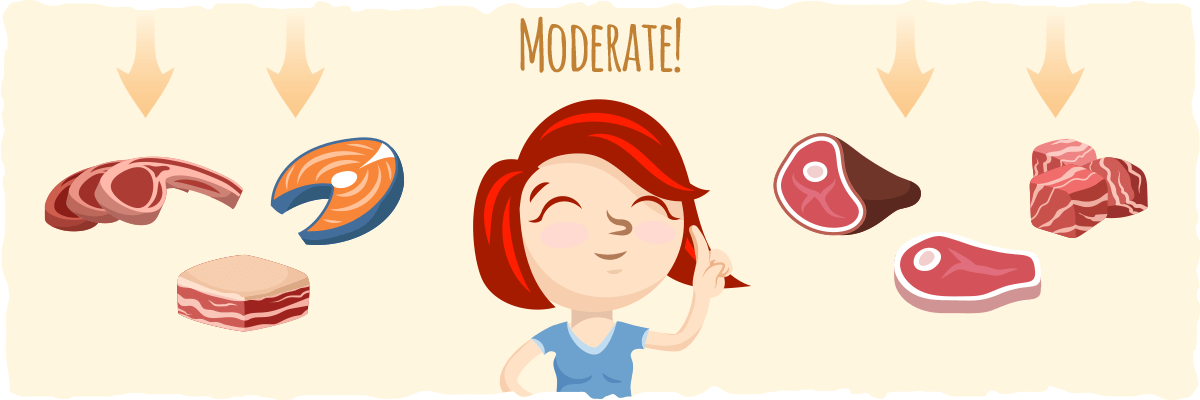
Your body’s protein requirements change depending on how many calories from carbs and fat you are eating. When you are on the ketogenic diet, for example, it is crucial to eat more protein to help maintain your health, preserve your muscle mass, and fuel gluconeogenesis.
Here are some guidelines to help you find your ideal daily protein intake:
- If you’re sedentary, we suggest between 0.6g and 0.8g protein per pound of lean body mass.
- If you’re active, we suggest between 0.8g and 1.0g protein per pound of lean body mass.
- If you lift weights, we suggest between 1.0g and 1.2g protein per pound of lean body mass.
You can always use our Keto Calculator as well. This will provide you with personalized protein, fat, and carb numbers to aim for on keto.
Studies also suggest that you should increase your protein intake if you are restricting calories and/or if you have a lower body fat percentage. Whether you are lean or in a calorie deficit to lose weight, it is important to stay at the higher end of the protein ranges that are suggested above.
For example, sedentary individuals who are restricting calories to lose fat should consume closer to 0.8 grams of protein per pound per day rather than 0.6 grams of protein per pound per day.
Now that you know the “what” and “why” behind gluconeogenesis and the keto diet, let’s dive deeper into the “how” with a quick recap of what we learned and some practical suggestions.
Practical Takeaways for Keto Protein Intake, Gluconeogenesis, and Ketosis
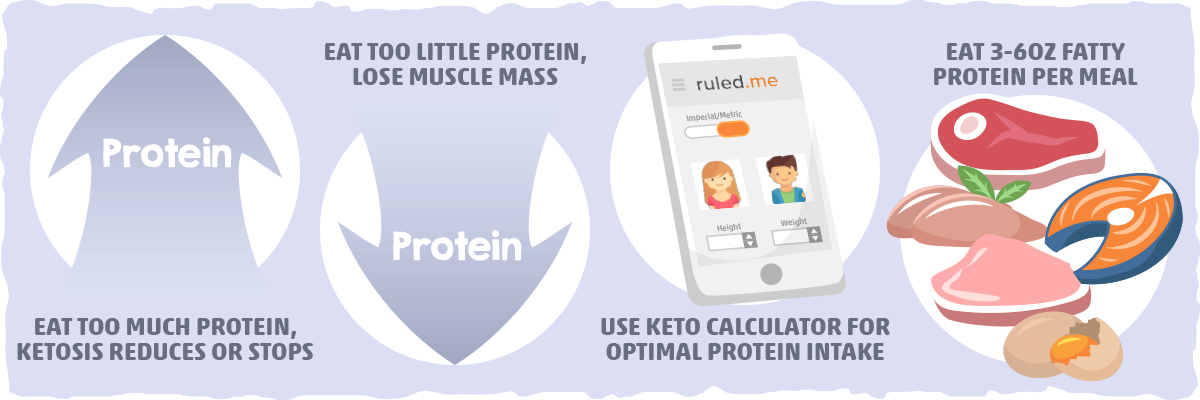
Gluconeogenesis may be keeping you from getting the result you want. This is why eating the right amount of protein is critical.
If you overeat protein, your body may rarely shift into ketosis. Conversely, if you eat too little protein, you will lose muscle mass and find it harder to stick with your diet.
To find the optimal protein intake for you, follow the recommendations above or use our Keto Calculator.
The best protein sources for keto will be fatty meat, fish, and eggs. In general, each meal should include 3-6 ounces (or 1-2 palm-sized portions) of a high-protein food, such as ground beef, steak, salmon, eggs, or chicken thighs.
You can also get your protein from leaner meats like chicken breast, turkey, or pork chops — Just make sure to add some extra fat to the meal.
What About Protein Timing for Ketosis?
When you eat your protein is as important as how much protein you eat. To figure out when you should eat your protein, we must understand what happens when we consume a high-protein meal.
In one study, researchers found that blood nitrogen levels continued to rise 8 hours after a high-protein meal. This means that the steak you ate for dinner can still be used to build muscle and repair the body while you sleep. Whether you eat one steak 3 hours before the next one or eat two whole steaks in one sitting doesn’t matter as much as we once thought. The digested amino acids will be slowly released into the bloodstream regardless of how much protein is eaten at one sitting.
This is great news for those of you who only want to build muscle. All you have to do is eat a lot of protein every day — it doesn’t matter when. But what if you want to build muscle and stay in ketosis?
Being in Ketosis and Building Muscle — Is It Possible?
Building muscle while you’re on a ketogenic diet seems difficult, especially when you consider what we have already discussed in this article.
When you are glycogen depleted and eat a high-protein meal, insulin increases. Increased insulin levels make it difficult for you to burn fat for fuel. Because of this, your body will start using gluconeogenesis as its dominant energy pathway instead of ketogenesis. However, this doesn’t mean that you can’t build muscle on a ketogenic diet.
As long as you eat high levels of protein and consume more calories than you need, you can still build muscle. However, staying in ketosis while you are having excess protein and calories throughout the day will be difficult. This is why eating protein at the right times is so important.

How To Get Into Ketosis Quickly Without Losing Muscle
With proper protein timing, you can minimize gluconeogenesis and maximize ketogenesis. One of the simplest ways to do this is by combining fasted exercise and intermittent fasting together.
Using Exercise to Stimulate Ketosis
Start by working out within an hour of waking up (without eating anything). Any form of exercise will do — they will all help you get into ketosis by stimulating fat oxidation, depleting glycogen stores, and improving insulin levels.
During endurance exercise, for example, the body preferentially burns fat and glycogen for fuel. Once glycogen is depleted, the body is more likely to shift into ketosis. However, you may have to walk for 3-4 hours at a brisk pace before you even touch ketosis.
A quicker way to deplete glycogen stores is by doing a high-intensity exercise like CrossFit or resistance training for 45 minutes to an hour. High-intensity exercise forces your body to burn glycogen stores so rapidly that your body has to use fat for fuel as you recover.
Another benefit of high-intensity exercise is that it significantly improves insulin sensitivity. Simply put, this means that high-intensity exercise causes your cells to need less insulin than they did previously. This leads to lower insulin levels and a greater chance that fat and ketones will become your primary fuel sources while you are at rest or doing low-intensity exercise. Too much high-intensity exercise, however, is counter-productive because it increases cortisol levels, which activates gluconeogenesis.
Regardless if you are a high-intensity interval trainer or you prefer to walk, make sure you are getting more than an hour of low-intensity activity every day. Walking, doing housework, and cycling are all examples of low-intensity activity that can improve your body’s insulin levels and promote ketosis.
Using Intermittent Fasting To Down-Regulate Gluconeogenesis

After you finish your fasted exercise session, take a couple hours to cool down and recover without food. After you’ve fasted for 16-20 hours from the last time you ate, have a high protein ketogenic meal.
Doing this allows you to take advantage of the increased insulin sensitivity that your cells have after exercise. The excess protein from your meal will be shuttled into cells without causing a significant rise in insulin. This will allow your body to burn fat for fuel and shift into ketosis, while it uses protein to rebuild and recover — The ideal scenario.
Here’s an example of what it’d look like to add an intermittent fast and fasted exercise into your daily schedule:
- Wake up.
- Do some form of exercise.
- Do some work and drink water as you recover.
- Eat your first meal. (at least 16 hours after the last meal you ate yesterday)
- Eat 1 to 2 more meals throughout the day that meet your macronutrient needs. (Use our keto calculator to find out how many calories from fat, protein, and carbohydrates you should eat per day.)
By doing this, you can maximize your body’s ability to use protein to re-build while it uses fat and ketones as fuel.
If you are interested in learning more about intermittent fasting, click here. But before you dig deeper into intermittent fasting, let’s put together everything we learned from this article.
Putting It All Together
Gluconeogenesis is the metabolic pathway your body uses to turn non-glucose sources into glucose for energy — a life-saving pathway. But it also can keep you from losing fat, gaining muscle, and burning ketones.
One way to minimize the negative effects of gluconeogenesis is by eating the right amount of protein at the right times. We suggest that you eat between 0.6 grams of protein to 1.2 grams of protein per pound of lean body mass per day. You should be closer to eating 1.2 grams per pound of lean body mass if you are more active and leaner. It is also important to increase your protein intake if you are restricting your calories for weight loss.
To shift your body into ketogenesis and away from gluconeogenesis more quickly, it is best to combine the ketogenic diet with fasted exercise and intermittent fasting. This will improve your insulin sensitivity, deplete your glycogen stores, and increase the likelihood that you will be burning fat and ketones rather than protein for fuel.
Sources:
- Nutrient timing revisited: is there a post-exercise anabolic window? — NCBI
- Carbohydrates for training and competition. — NCBI
- Effect of carbohydrate ingestion on glycogen resynthesis in human liver and skeletal muscle, measured by C MRS — APS
- Effect of glycogen availability on human skeletal muscle protein turnover during exercise and recovery — APS
- Very-low-carbohydrate diets and preservation of muscle mass — NCBI
- Ketogenic diet does not affect strength performance in elite artistic gymnasts — BioMed Central
- Resistance training in overweight women on a ketogenic diet conserved lean body mass while reducing body fat — BioMed Central
- Long-term Effects of a Very Low-Carbohydrate Diet and a Low-Fat Diet on Mood and Cognitive Function — The JAMA Network
- Relatively high-protein or ‘low-carb’ energy-restricted diets for body weight loss and body weight maintenance? — NCBI
- Effects of dietary carbohydrate restriction with high protein intake on protein metabolism and the somatotropic axis. — NCBI
- Energy metabolism in feasting and fasting. — NCBI
- Insulin effects in muscle and adipose tissue. — NCBI
- Energy Metabolism in the Liver — NCBI
- Metabolic Effects of the Very-Low-Carbohydrate Diets: Misunderstood “Villains” of Human Metabolism — NCBI
- Gluconeogenesis — Chemistry LibreTexts
- Fasting: The History, Pathophysiology and Complications — NCBI
- Nitrogen loss in normal and obese subjects during total fast. — NCBI
- Intense Exercise Has Unique Effects on Both Insulin Release and Its Roles in Glucoregulation — Diabetes
- Insulin levels during exercise critical to performance — Human Kinetics
- How Much Protein Do I Need? The Definitive (and Science-Based) Answer — Legion Athletics
- Aerobic Endurance Exercise or Circuit-Type Resistance Training for Individuals with Impaired Glucose Tolerance? — Thieme
- Endurance exercise training reduces glucose-stimulated insulin levels in 60- to 70-year-old men and women. — NCBI
- Muscle Mass Index As a Predictor of Longevity in Older Adults — Science Direct
- Cortisol increases gluconeogenesis in humans: its role in the metabolic syndrome. — NCBI
- Is Too Much Protein Bad for Ketosis? The Truth Behind How Much Protein You Need on Keto — Ruled.me